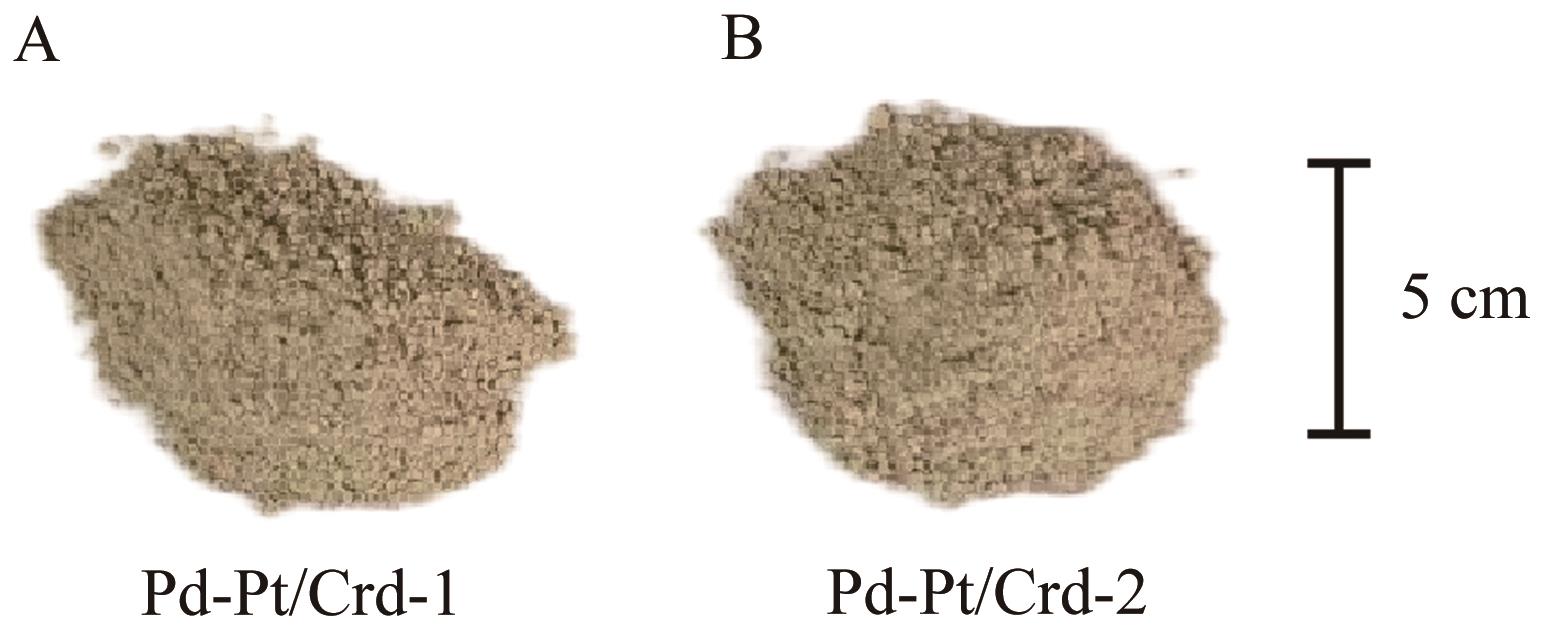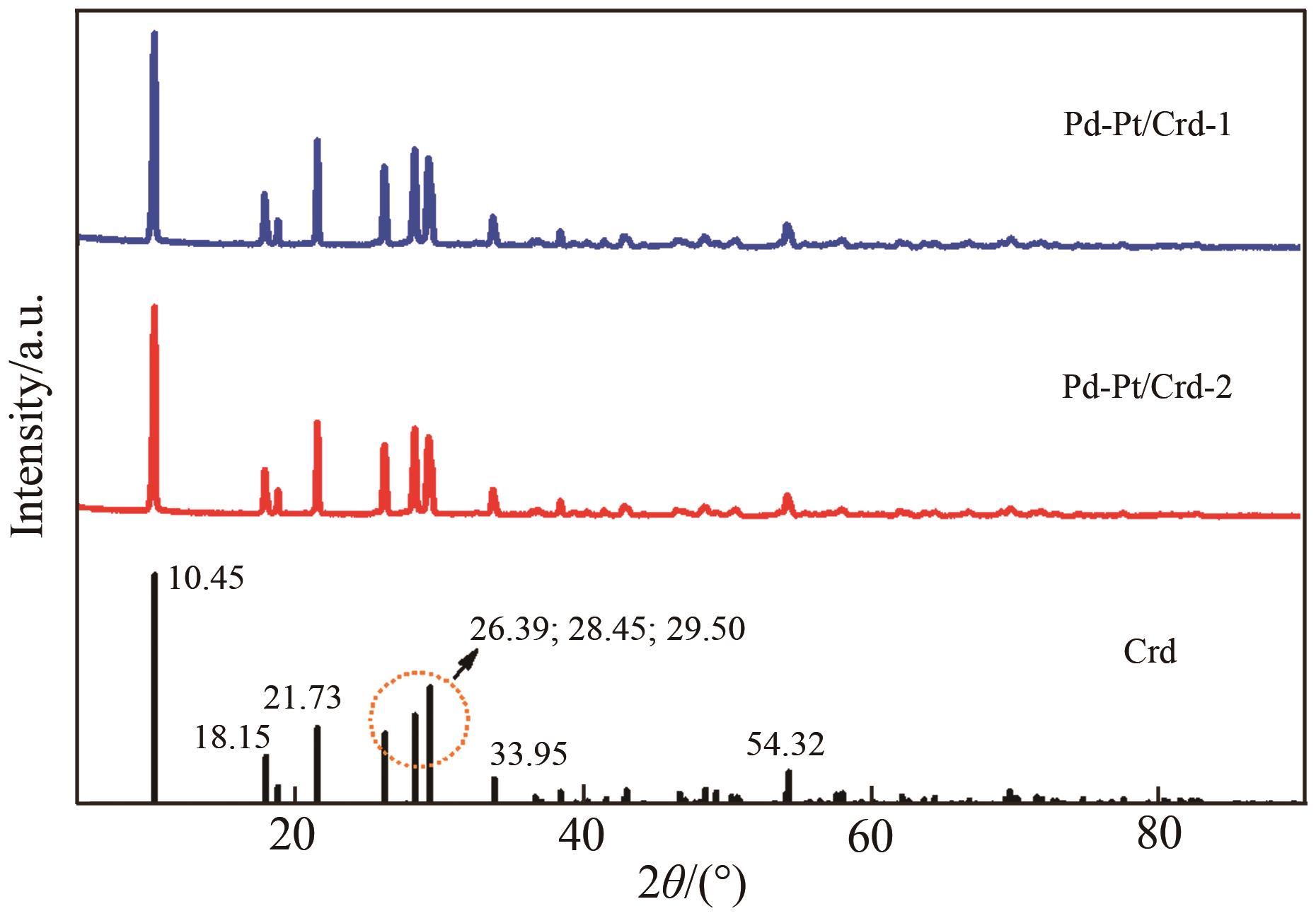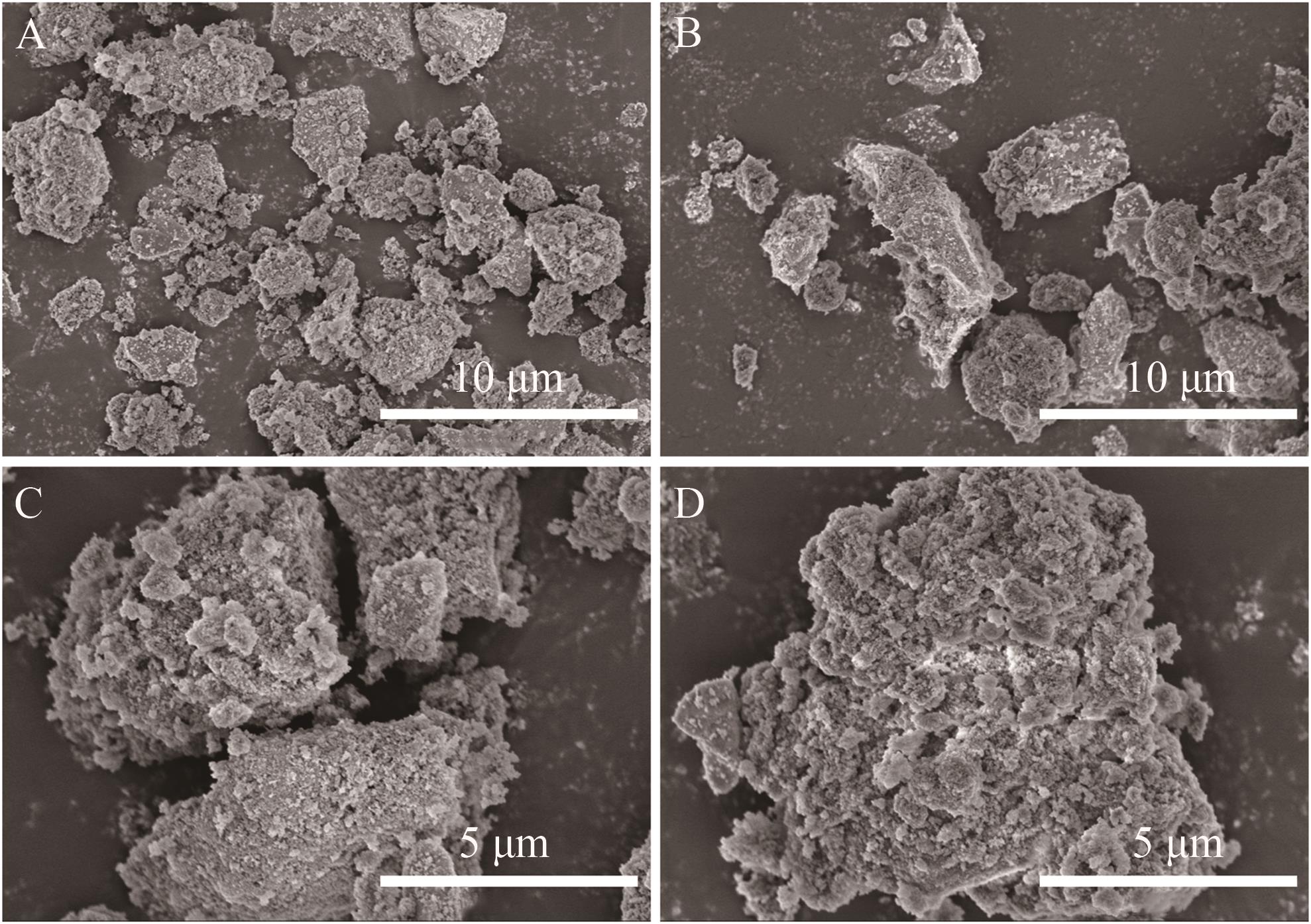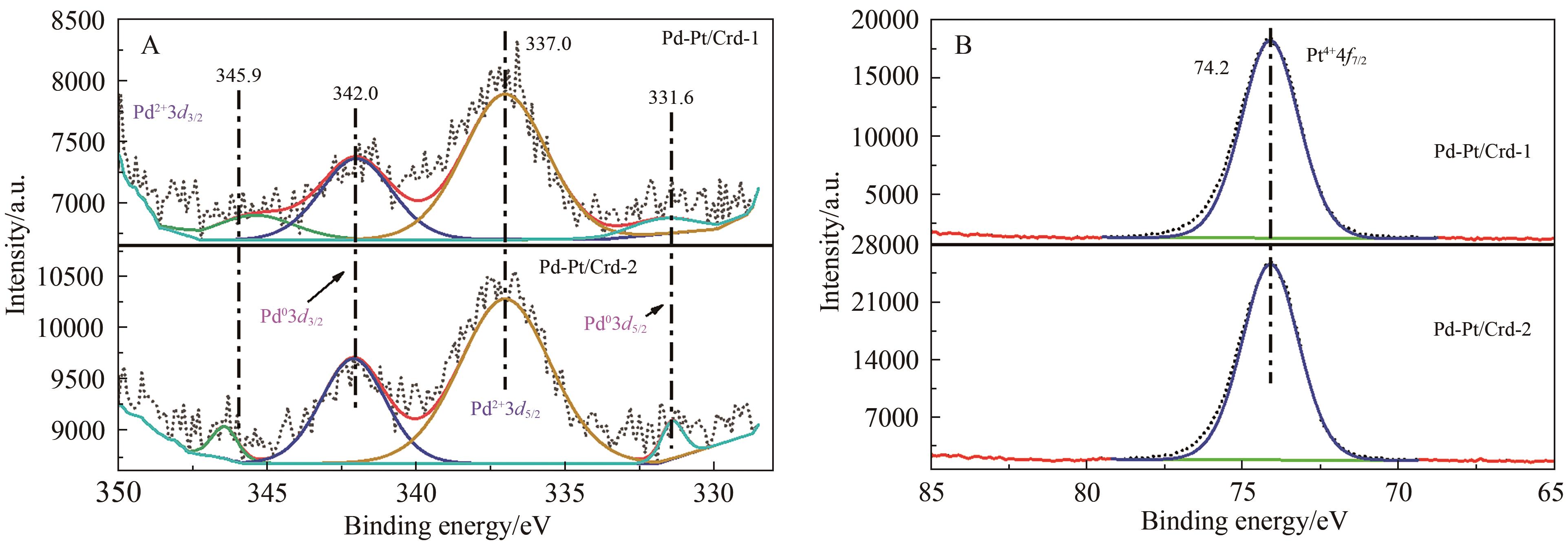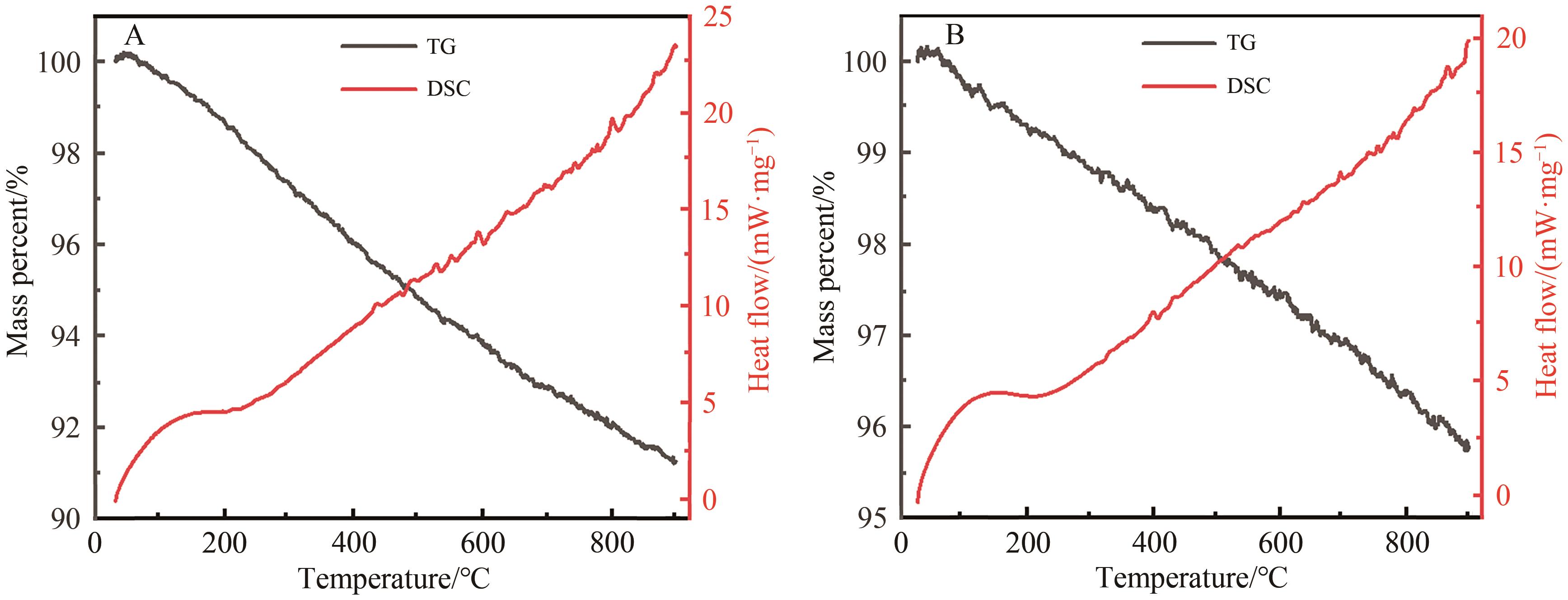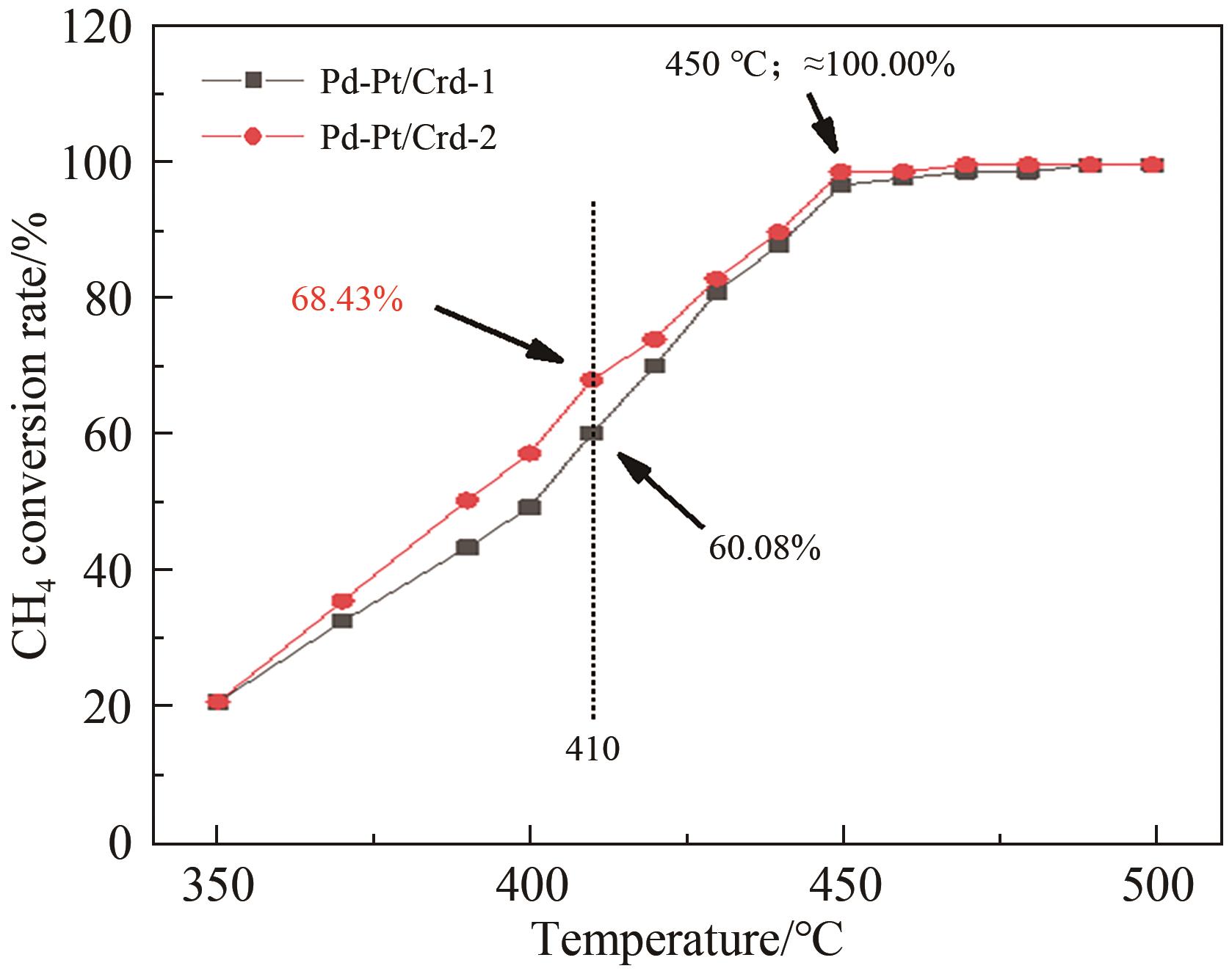
Chinese Journal of Applied Chemistry ›› 2024, Vol. 41 ›› Issue (11): 1620-1628.DOI: 10.19894/j.issn.1000-0518.240154
• Full Papers • Previous Articles Next Articles
Preparation and Catalytic Performance of Pd-Pt Type Catalyst Loaded with Cordierite for Methane Combustion
Li-Mei SUN1, Li-Mei GU1, Gang WANG1, Xiu-Juan ZHU1, Bin YU1, Hong-Yang WANG2, Jia-Lei LIU2( ), He-Chang SHI3
), He-Chang SHI3
- 1.Petroleum Engineering Technology Research Institute of Sinopec Shengli Oilfield Branch,Dongying 257000,China
2.Institute of Environment and Sustainable Development in Agriculture,Chinese Academy of Agricultural Sciences,Beijing 100081,China
3.Key Laboratory of Polymer Ecomaterials,Changchun Institute of Applied Chemistry,Chinese Academy of Sciences,Changchun 130022,China
-
Received:2024-05-12Accepted:2024-10-19Published:2024-11-01Online:2024-12-04 -
Contact:Jia-Lei LIU -
About author:liujialei@caas.cn
-
Supported by:the Projects of Sinopec Shengli Oilfield Branch(YC2308)
CLC Number:
Cite this article
Li-Mei SUN, Li-Mei GU, Gang WANG, Xiu-Juan ZHU, Bin YU, Hong-Yang WANG, Jia-Lei LIU, He-Chang SHI. Preparation and Catalytic Performance of Pd-Pt Type Catalyst Loaded with Cordierite for Methane Combustion[J]. Chinese Journal of Applied Chemistry, 2024, 41(11): 1620-1628.
share this article
Add to citation manager EndNote|Ris|BibTeX
URL: http://yyhx.ciac.jl.cn/EN/10.19894/j.issn.1000-0518.240154
| Catalyst | Specific surface area/(m2·g-1) | Total pore volume/(cm3·g-1) | Average pore diameter/nm |
|---|---|---|---|
| Pd-Pt/Crd-1 | 14.983 9 | 0.063 0 | 16.821 0 |
| Pd-Pt/Crd-2 | 11.407 0 | 0.046 7 | 16.377 6 |
Table 1 The structural parameters of Pd-Pt/Crd catalyst
| Catalyst | Specific surface area/(m2·g-1) | Total pore volume/(cm3·g-1) | Average pore diameter/nm |
|---|---|---|---|
| Pd-Pt/Crd-1 | 14.983 9 | 0.063 0 | 16.821 0 |
| Pd-Pt/Crd-2 | 11.407 0 | 0.046 7 | 16.377 6 |
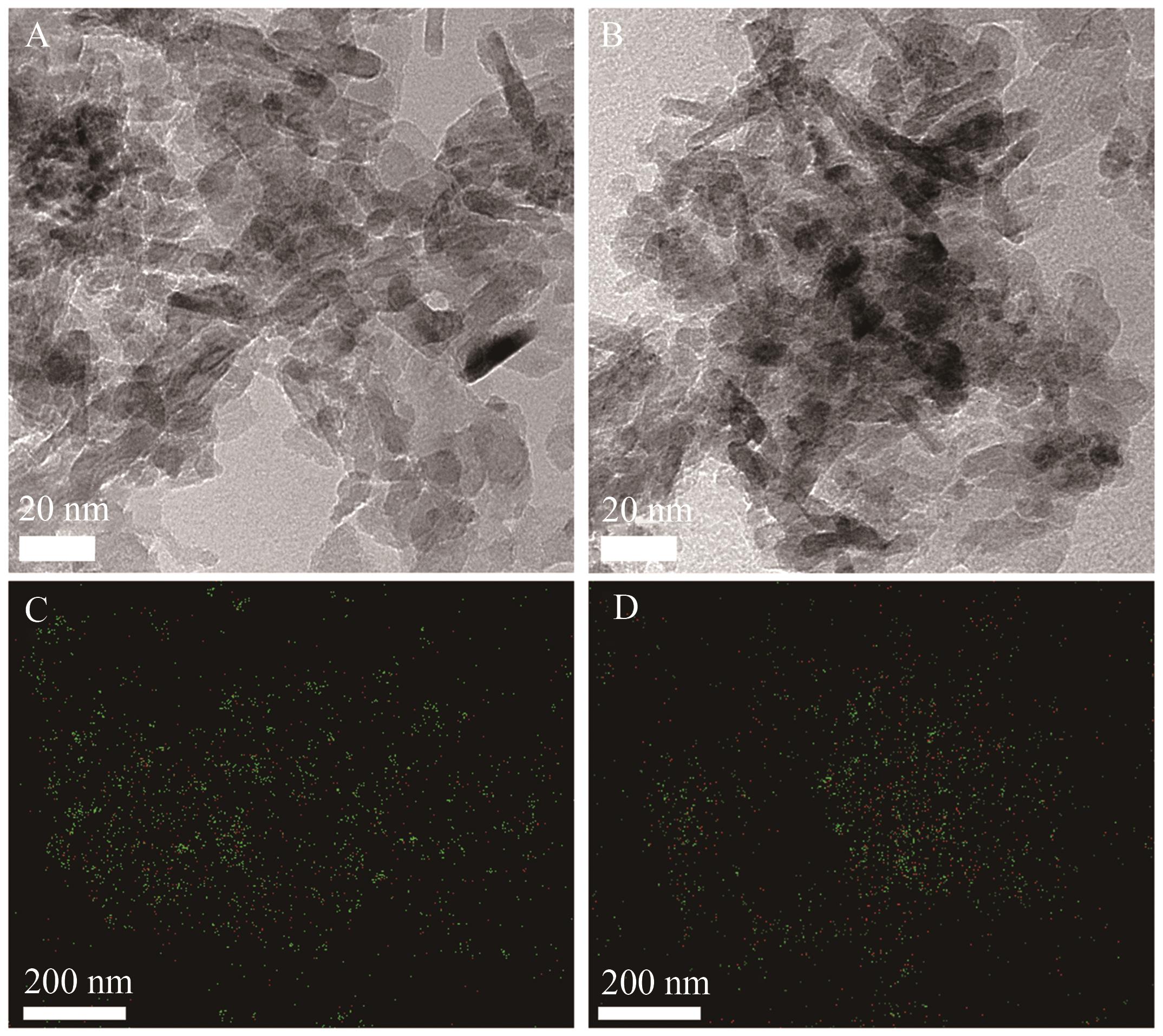
Fig.4 The TEM image of Pd-Pt/Crd-1 (A) and Pd-Pt/Crd-2 (B); The elemental mapping images of energy-dispersive spectroscopy for Pd-Pt/Crd-1 (C) and Pd-Pt/Crd-2 (D) (green: Pd; red: Pt)
| 1 | CARAVAGGIO G, NOSSOVA L, TURNBULL M J. Nickel-magnesium mixed oxide catalyst for low temperature methane oxidation[J]. Chem Eng J, 2021, 405: 126862. |
| 2 | BEERLING D, BERNER R A, MACKENZIE F T, et al. Methane and the CH4 related greenhouse effect over the past 400 million years[J]. Am J Sci, 2009, 309(2): 97-113. |
| 3 | AHMAD Y H, MOHAMED A T, AL-QARADAWI S Y. Exploring halloysite nanotubes as catalyst support for methane combustion: influence of support pretreatment[J]. Appl Clay Sci, 2021, 201: 105956. |
| 4 | 张兆瑞, 党文龙, 耿丽. 煤矿乏风瓦斯燃烧用催化剂研究进展[J]. 陕西煤炭, 2020, 39(S01): 127-133. |
| ZHANG Z R, DAND W L, GENG L. Research progress of the catalysts for catalytic combustion of coal mine ventilation air methane[J]. Shaanxi Coal, 2020, 39(S01): 127-133. | |
| 5 | 苗飞飞, 毛东森, 郭晓明, 等. 甲烷催化燃烧催化剂的研究进展[J]. 应用技术学报, 2019, 19(3): 242-248. |
| MIAO F F, MAO D S, GUO X M, et al. Research advances in catalysts for methane catalytic combustion[J]. J Technol, 2019, 19(3): 242-248. | |
| 6 | 严河清, 张甜, 王鄂凤, 等. 甲烷催化燃烧催化剂的研究进展[J]. 武汉大学学报(理学版), 2005, 51(2): 161-166. |
| YAN H Q, ZHANG T, WANG E F, et al. Research of the catalysts for methane catalytic combustion[J]. J Wuhan Univ (Nat Sci Ed), 2005, 51(2): 161-166. | |
| 7 | 匡浩浩, 蒋艳刚, 马海乐, 等. Pd基催化剂载体对天然气催化燃烧影响的研究进展[J]. 低碳化学与化工, 2024, 49(4): 12-22. |
| KUANG H H, JIANG Y G, MA H L, et al. Research progress on influence of Pd-based catalyst supports on natural gas catalytic combustion[J]. Low-Carbon Chem Chem Eng, 2024, 49(4): 12-22. | |
| 8 | MURATA K, KOSUGE D, OHYAMA J, et al. Exploiting metal-support interactions to tune the redox properties of supported Pd catalysts for methane combustion[J]. ACS Catal, 2019, 10(2): 1381-1387. |
| 9 | NISBET E G, DLUGOKENCKY E J, BOUSQUET P. Methane on the rise-again[J]. Science, 2014, 343(6170): 493-495. |
| 10 | HU W, SHAO Z J, CAO X M, et al. Multi sites vs single site for catalytic combustion of methane over Co3O4 (110): a first-principles kinetic Monte Carlo study[J]. Chin J Catal, 2020, 41(9): 1369-1377. |
| 11 | ZHU G, HAN J, ZEMLYANOV D Y, et al. The turnover rate for the catalytic combustion of methane over palladium is not sensitive to the structure of the catalyst[J]. J Am Chem Soc, 2004, 126(32): 9896-9897. |
| 12 | 王胜, 高典楠, 张纯希, 等. 贵金属甲烷燃烧催化剂[J]. 化学进展, 2008, 20(6): 789. |
| WANG S, GAO D N, ZHANG C X, et al. Low-temperature catalytic combustion of methane over noble metal catalyst[J]. Prog Chem, 2008, 20(6): 789. | |
| 13 | 汪晓峰, 陈加灿, 胡宏, 等. La0.8Sr0.2MnxNi1- xO3催化剂制备及其催化甲烷燃烧性能研究[J]. 山东化工, 2024, 53(3): 43-46. |
| WANG X F, CHEN J C, HU H, et al. Preparation of La0.8Sr0.2MnxNi1- xO3 catalysts and the catalytic performance for methane combustion[J]. Shandong Chem Ind, 2024, 53(3): 43-46. | |
| 14 | 楚培齐, 王赛飞, 赵世广, 等. 甲烷催化燃烧反应机理及催化剂研究进展[J]. 燃料化学学报, 2022, 50(2): 180-194. |
| CHU P Q, WANG S F, ZHAO S G, et al. Research progress of reaction mechanism and catalysts on catalytic methane combustion[J]. J Fuel Chem Technol, 2022, 50(2): 180-194. | |
| 15 | WANG X, ZHANG X, CAO M, et al. Ordered mesoporous Pd-La/Al2O3 catalysts for enhanced methane combustion[J]. Energy Fuel, 2022, 36(13): 6999-7005. |
| 16 | JANG E J, LEE J, OH D G, et al. CH4 oxidation activity in Pd and Pt-Pd bimetallic catalysts: correlation with surface PdOx quantified from the DRIFTS study[J]. ACS Catal, 2021, 11(10): 5894-5905. |
| 17 | COLUSSI S, FORNASIERO P, TROVARELLI A. Structure-activity relationship in Pd/CeO2 methane oxidation catalysts[J]. Chin J Catal, 2020, 41(6): 938-950. |
| 18 | KONG Q, FENG W, ZHU X, et al. Fabrication, characterization and electrochemical properties of porous palladium bulk samples with high porosity and hierarchical pore structure[J]. Chin J Catal, 2017, 38(6): 1038-1044. |
| 19 | LIU Y, WANG S, GAO D N, et al. In-situ FT-IR study on methane combustion over Pd/NiAl2O4 catalyst[J]. Chin J Catal, 2012, 33(9): 1552. |
| 20 | 高倩文, 王晓波, 邓存宝, 等. Pd-Pt/HZSM-5催化剂的制备及催化低浓度甲烷燃烧性能[J]. 精细化工, 2024, 41(8): 1788-1794. |
| GAO Q W, WANG X B, DENG C B, et al. Preparation of Pd-Pt/HZSM-5 catalysts and their catalytic performance for low-concentration methane combustion[J]. Fine Chem, 2024, 41(8): 1788-1794. | |
| 21 | DING S, CHEN H A, MEKASUWANDUMRONG O, et al. High-temperature flame spray pyrolysis induced stabilization of Pt single-atom catalysts[J]. Appl Catal B-Environ, 2021, 281: 119471. |
| 22 | CHEN B, LIN J, CHEN X, et al. Controllable synthesis of mesoporous alumina as support for palladium catalysts and reconstruction of active sites during methane combustion[J]. Int J Hydrogen Energy, 2020, 45(30): 15142-15156. |
| 23 | LUO L, WANG S, WU Z, et al. Influence of the ZSM-5 support acidity on the catalytic performance of Pd/ZSM-5 in lean methane oxidation[J]. Chem Res Chin Univ, 2022, 38(1): 229-236. |
| 24 | 邓先功. 发泡-注凝成型法制备莫来石柱晶自增强多孔陶瓷及其高温力学和热学性能[D]. 武汉: 武汉科技大学, 2016. |
| DENG X G. Preparation, high temperature mechanicaland insulation thermal properties ofelongated mullite self-reinforced porousceramics via foam-gelcasting method[D]. Wuhan: Wuhan University of Science and Technology, 2016. | |
| 25 | 秦梦黎. 堇青石合成及晶须原位增强堇青石质隔热材料的研究[D]. 武汉: 武汉科技大学, 2018. |
| QIN M L. Study on the synthesis of cordierite andwhiskers in-situ reinforced cordieritethermal insulation materials[D]. Wuhan: Wuhan University Science Technology, 2018. | |
| 26 | WANG S, WANG H, CHEN Z, et al. Fabrication and characterization of porous cordierite ceramics prepared from fly ash and natural minerals[J]. Ceram Int, 2019, 45(15): 18306-18314. |
| 27 | LI F, SHEN B, TIAN L, et al. Enhancement of SCR activity and mechanical stability on cordierite supported V2O5-WO3/TiO2 catalyst by substrate acid pretreatment and addition of silica[J]. Powder Technol, 2016, 297: 384-391. |
| 28 | 李昊, 李翠伟, 汪长安. 轻质高强堇青石多孔陶瓷的制备与表征[J]. 陶瓷学报, 2021, 42(4): 632-638. |
| LI H, LI C W, WANG C A. Preparation and characterization of porous cordierite ceramics with lightweight and high strength[J]. J Ceram, 2021, 42(4): 632-638. | |
| 29 | 徐卫, 侯蕾, 杜霞茹, 等. 蜂窝陶瓷负载Pd基整体式催化剂制备及催化燃烧性能[J]. 工业催化, 2019, 27(11): 54-56. |
| XU W, HOU L, DU X R, et al. Preparation and properties of honeycomb ceramic supported Pd based monolithic catalyst for catalytic combustion[J]. Ind Catal, 2019, 27(11): 54-56. | |
| 30 | LI J W, ZHANG J J, LEI Z G, et al. Pd-Co coating onto cordierite monoliths as structured catalysts for methane catalytic combustion[J]. Energy Fuel, 2012, 26(1): 443-450. |
| 31 | LIAO H, ZUO P, LIU M. Study on the correlation between the surface active species of Pd/cordierite monolithic catalyst and its catalytic activity[J]. Mat Sci Eng B, 2016, 211: 45-52. |
| 32 | CUI X, LI H, WANG Y, et al. Room-temperature methane conversion by graphene-confined single iron atoms[J]. Chem, 2018, 4(8): 1902-1910. |
| [1] | Dong-Hao LYU, Lan-Lan XU, Xiao-Juan LIU. The Properties of Narrow Bandgap β-CuFeO2 Ferroelectric Photocatalysts and Surface Oxygen Evolution Reaction Characteristics [J]. Chinese Journal of Applied Chemistry, 2024, 41(7): 1010-1023. |
| [2] | Tian-Li SUN, Guo ZHU, Hai HE, Bing-Kun HUANG, Zhao-Kun XIONG, Bo LAI. Research Prospect of Single-Atom Catalysts for Fenton-Like Water Treatment [J]. Chinese Journal of Applied Chemistry, 2024, 41(2): 217-229. |
| [3] | Tian-Yao SHEN, Yi YANG, Hai-He YU, Peng XU, Guang-Shan ZHANG, Peng WANG. Preparation of CoFe-LDH/Copper Foam and Its Catalytic Performance and Mechanism of Diuron Degradation by Dielectric Barrier Discharge Plasma in Water [J]. Chinese Journal of Applied Chemistry, 2024, 41(2): 243-255. |
| [4] | Jian-Tian LU, Jin-Hui ZOU, Bo-Lin ZHAO, Yu-Wei ZHANG. Research Progress on the Application of Inorganic Nanoparticle Enzyme in the Field of Analytical Sensing [J]. Chinese Journal of Applied Chemistry, 2024, 41(1): 60-86. |
| [5] | Er-Gui LUO, Tao TANG, Yi WANG, Jun-Ming ZHANG, Yu-Hong CHANG, Tian-Jun HU, Jian-Feng JIA. Progress on Tuning the Geometric and Electronic Structure of Precious Metal Catalysts for Hydrogen Peroxide Production via Two-Electron Oxygen Reduction [J]. Chinese Journal of Applied Chemistry, 2023, 40(8): 1063-1076. |
| [6] | Yin-Nan QIAN, Chuan SHI, Wei ZHANG, Zhao-Yan LUO. Research Progress of Noble Metal Electrocatalysts for Oxygen Evolution Reaction in Acidic Environment [J]. Chinese Journal of Applied Chemistry, 2023, 40(8): 1126-1139. |
| [7] | Rui-Xue ZHENG, Qing-Lei MENG, Li ZHANG, Chang-Peng LIU, Wei XING, Mei-Ling XIAO. Hierarchically Porous Fe-N-C Catalysts for Efficient Electrocatalytic Oxygen Reduction Reaction [J]. Chinese Journal of Applied Chemistry, 2023, 40(8): 1187-1194. |
| [8] | Ning YUAN, Jie MA, Jin-Ling ZHANG, Jian-Sheng ZHANG. Preparation of PCN-6(M) Bimetallic Organic Framework Materials by Steam-assisted Method and Their CO2 and CH4 Adsorption Performance [J]. Chinese Journal of Applied Chemistry, 2023, 40(6): 896-903. |
| [9] | Bing LI, Jun-Hui LIU, Ya-Kun SONG, Xiang LI, Xu-Ming GUO, Jian XIONG. Recent Advances in Application of Metal-Organic Frameworks for Hydrogen Generation by Catalytic Hydrolysis of Ammonia Borane [J]. Chinese Journal of Applied Chemistry, 2023, 40(3): 329-340. |
| [10] | Lu-Fei WANG, Meng-Meng ZHEN, Bo-Xiong SHEN. Research Progress of Controlling Lithium-Sulfur Batteries by Electrocatalysts under Lean Electrolyte Conditions [J]. Chinese Journal of Applied Chemistry, 2023, 40(2): 188-209. |
| [11] | Ke-Xin YANG, Jie ZHOU, Yu-Shan HOU, Yao-Wei ZHANG, Chen YIN, Dong-Hui XU, Guang-Yang LIU. Research Progress on Preparation and Adsorption of Water Pollutants of Bimetallic Metal-Organic Framework [J]. Chinese Journal of Applied Chemistry, 2023, 40(12): 1630-1642. |
| [12] | Lin-Feng WANG, Hui TIAN, Guang-Bi GONG, Chun-Ji WU, Bao-Li WANG, Dong-Mei CUI. Terpolymerization of Ethylene, Cyclic Olefin and 1-Octene Catalyzed by Rare Earth Complexes [J]. Chinese Journal of Applied Chemistry, 2023, 40(10): 1396-1404. |
| [13] | Shan SHAO, Jian ZHANG, Kai-Qiang DENG, Jie YANG, Shao-Ming YANG. Detection of Dopamine by Enzyme‑Free Sensor Constructed by Nickel‑Cobalt Bimetallic‑porphyrin Organic Framework Composites [J]. Chinese Journal of Applied Chemistry, 2022, 39(7): 1098-1107. |
| [14] | Chao ZHANG. Research Prospect of Single Atom Catalysts Towards Electrocatalytic Reduction of Carbon Dioxide [J]. Chinese Journal of Applied Chemistry, 2022, 39(6): 871-887. |
| [15] | Yan WANG, Shu-Cong ZHANG, Xing-Kun WANG, Zhi-Cheng LIU, Huan-Lei WANG, Ming-Hua HUANG. Research Progress on Transition Metal⁃Based Catalysts for Hydrogen Evolution Reaction via Seawater Electrolysis [J]. Chinese Journal of Applied Chemistry, 2022, 39(6): 927-940. |
| Viewed | ||||||
|
Full text |
|
|||||
|
Abstract |
|
|||||
